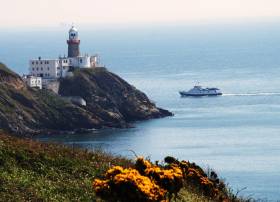Displaying items by tag: World Navigation Day
The General Lighthouse Authority which is responsible for England, Wales, Channel Islands and Gibraltar, Trinity House is joining aids to navigation authorities around the world to mark the first ever World Marine Aids to Navigation Day held today, July 1st.
In addition to Trinity House, Afloat adds the other GLA counterparts are the Commissioners of Irish Lights and the Northern Lighthouse Board responsible for Scottish waters and the Isle of Man. Today's inaugural event is established to celebrate and promote the role of marine aids to navigation (AtoNs) and highlight the importance of safety at sea.
The body behind the day is IALA (the International Association of Marine Aids to Navigation and Lighthouse Authorities), a non-profit international technical association established in 1957 to gather together marine aids to navigation authorities, manufacturers, consultants and scientific and training institutes from all parts of the world.
IALA’s 305 members—whether national or industrial—assemble across a number of committees and working groups to exchange and compare their experiences and achievements, with a view to drafting and publishing IALA Standards, Recommendations and Guidelines.
The aim of IALA—to which Trinity House subscribes and contributes—is to foster the safe, economic and efficient movement of vessels, through improvement and harmonisation of aids to navigation worldwide and other appropriate means, for the benefit of the maritime community and the protection of the environment. Trinity House was a founding member of IALA in 1957.
The idea of launching the World Marine Aids to Navigation Day annually on 1 July was agreed at IALA’s 2018 conference in the Republic of Korea.
As a focal point for highlighting the importance of aids to navigation as a service for all mariners, Trinity House has chosen to emphasise its statutory duty as an auditor and inspector of local aids to navigation, rather than its more well-known duty as a provider of general aids to navigation such as lighthouses, lightvessels and buoys.
Local aids to navigation are owned and operated by Local Lighthouse Authorities rather than Trinity House, but the powers and duties granted to Trinity House by the Merchant Shipping Act 1995 require it to audit and inspect over 11,000 local AtoNs. The work is carried out by Trinity House’s Inspector of Seamarks and the Local AtoN Manager, both of whom enjoy meeting local operators and seeing so many often-hidden corners of the nation.
Inspector of Seamarks Captain Graeme Proctor says of the cyclical inspection schedule: “It’s a lot like painting the Forth Bridge, but I really enjoy meeting local Harbour Masters and their teams. It is hard work and a lot of long days, but there will often be a cup of tea waiting for me in the harbour office in the winter and we do enjoy an ice cream by the seaside in the summer months. Although it may not be the most famous of Trinity House’s contributions to maritime Britain, it’s a vital role for safety and is great for keeping us in touch with local aids to navigation providers and the marine users themselves.”
Maritime Minister Nusrat Ghani said: “Lighthouses have a place in all of our hearts but their longstanding role can never be underestimated. Aids to navigation are crucial to keeping people safe at sea, alerting them to potential dangers. Our lighthouse authorities, including Trinity House, do a fantastic job of keeping our lighthouses, buoys and other assistance vessels in good condition around the clock.”
Trinity House and IALA encourage everyone with an appreciation of the various types of marine aid to navigation to take to social media to share their favourite AtoNs with #WAtoNDay.






























































